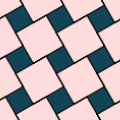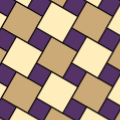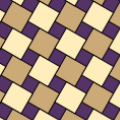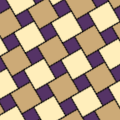File:Academ Periodic tiling by squares of two different sizes.svg

Original file (SVG file, nominally 750 × 750 pixels, file size: 716 bytes)
Captions
Captions
Summary edit
| DescriptionAcadem Periodic tiling by squares of two different sizes.svg |
English: In order to prove the Pythagorean theorem, such a tessellation and its pattern grid can be associated to a set of puzzle pieces, as shown below.
This classical tiling is created from a given right triangle. An Euclidean plane is entirely covered with an infinity of squares, the sizes of which are the leg lengths of the given triangle: a and b. On this drawing, every square element of the tiling has a slope equal to the ratio of sizes: a / b = tan 22.5°, and a square pattern is indefinitely repeated horizontally and vertically, if we forget patternTransform="rotate(67.5)": see <pattern id="pg" in the source code. See another page for more informations. |
| Date | |
| Source | Own work |
| Author | Baelde |
| Other versions |
 On three previous images, the hypotenuses of copies of the given triangle are in dashed red. On left, a periodic square in dashed red takes another position relative to the tiling: its center is the one of a small tile. And one of the puzzle pieces is square, its size is the one of a small tile. The four other puzzle pieces can form together another tile, and they are congruent, because of a rotation of a quarter turn around the center of a large tile that transforms at the same time the tiling and the grid in dashed red into themselves. Therefore the area of a large tile equals four times the area of one of these four puzzle pieces. In case where the initial triangle is isosceles, the midpoint of any segment in dashed red is a common vertex of four tiles with equal sizes: a = b, and each puzzle piece which is a quarter of a tile is an isosceles triangle. Whatever the shape of the initial triangle, the two assemblages of the five puzzle pieces have equal areas: Periodic tilings by squares, images coded with a pattern element in SVG |
| SVG development InfoField | This /Baelde was created with a text editor. |
Licensing edit
- You are free:
- to share – to copy, distribute and transmit the work
- to remix – to adapt the work
- Under the following conditions:
- attribution – You must give appropriate credit, provide a link to the license, and indicate if changes were made. You may do so in any reasonable manner, but not in any way that suggests the licensor endorses you or your use.
- share alike – If you remix, transform, or build upon the material, you must distribute your contributions under the same or compatible license as the original.

|
Permission is granted to copy, distribute and/or modify this document under the terms of the GNU Free Documentation License, Version 1.2 or any later version published by the Free Software Foundation; with no Invariant Sections, no Front-Cover Texts, and no Back-Cover Texts. A copy of the license is included in the section entitled GNU Free Documentation License.http://www.gnu.org/copyleft/fdl.htmlGFDLGNU Free Documentation Licensetruetrue |
File history
Click on a date/time to view the file as it appeared at that time.
| Date/Time | Thumbnail | Dimensions | User | Comment | |
|---|---|---|---|---|---|
| current | 09:00, 26 September 2012 |  | 750 × 750 (716 bytes) | Baelde (talk | contribs) | {{Information |Description ={{en|1=The image evokes a covering of the entire Euclidean plane with an infinity of squares of two different sizes.}} |Source ={{own}} |Author =Baelde |Date =2012-09-26 |Per... |
You cannot overwrite this file.
File usage on Commons
The following 25 pages use this file:
- File:A Pythagorean tiling View 1.svg
- File:A Pythagorean tiling View 2.svg
- File:A Pythagorean tiling View 3.svg
- File:A Pythagorean tiling View 4.svg
- File:A Pythagorean tiling View 5.svg
- File:A Pythagorean tiling View 6.svg
- File:A Pythagorean tiling View 7.svg
- File:A Pythagorean tiling View 8.svg
- File:A pattern of Pythagorean tiling.svg
- File:A regular tiling by squares 45 degrees slanted.svg
- File:A tiling in order to prove the Pythagorean theorem.svg
- File:A tri-colored Pythagorean tiling View 1.svg
- File:A tri-colored Pythagorean tiling View 2.svg
- File:A tri-colored Pythagorean tiling View 3.svg
- File:A tri-colored Pythagorean tiling View 4.svg
- File:A tri-colored Pythagorean tiling View 5.svg
- File:A tri-colored Pythagorean tiling View 6.svg
- File:A tri-colored Pythagorean tiling View 7.svg
- File:A tri-colored Pythagorean tiling View 8.svg
- File:Academ Periodic tiling by squares of two kinds.svg
- File:Academ Pythagorean theorem through a tiling pattern.svg
- File:Academ Pythagorean tiling and Pythagorean theorem.svg
- File:Academ Squares of two kinds in a periodic tiling.svg
- File talk:A Pythagorean tiling View 1.svg
- Category talk:Pythagorean tiling
File usage on other wikis
The following other wikis use this file:
- Usage on en.wikipedia.org
- Usage on es.wikipedia.org
- Usage on fr.wikipedia.org
- Usage on ro.wikipedia.org
- Usage on ru.wikipedia.org
- Usage on uk.wikipedia.org
Metadata
This file contains additional information such as Exif metadata which may have been added by the digital camera, scanner, or software program used to create or digitize it. If the file has been modified from its original state, some details such as the timestamp may not fully reflect those of the original file. The timestamp is only as accurate as the clock in the camera, and it may be completely wrong.
| Width | 750 |
|---|---|
| Height | 750 |




















